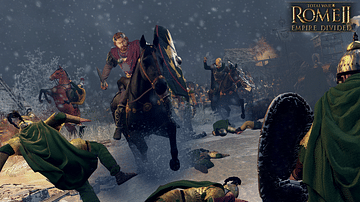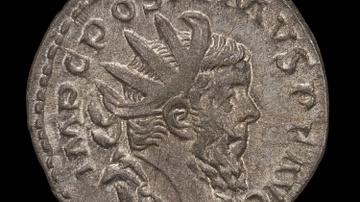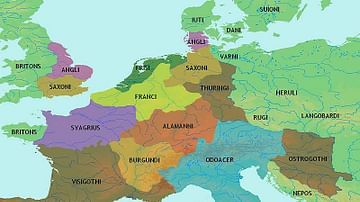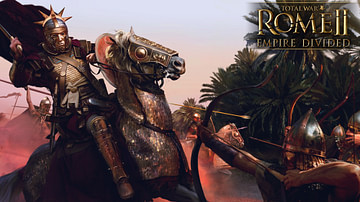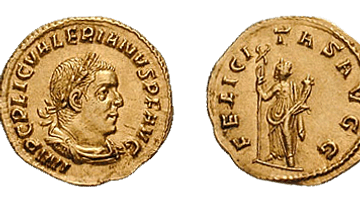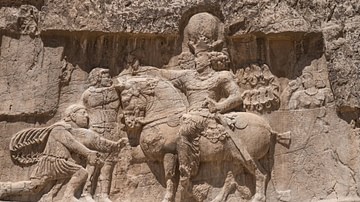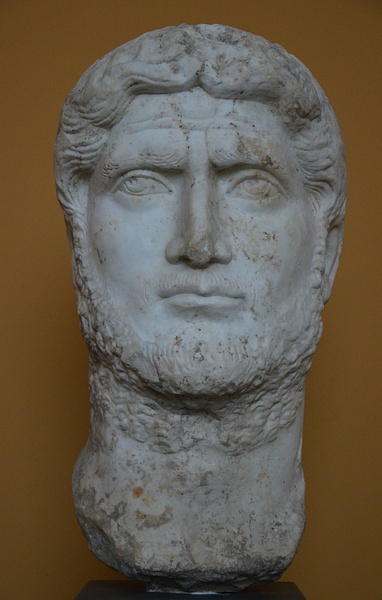
Gallienus was Roman emperor from 253 to 268 CE. Publius Licinius Egnatius Gallienus, the eldest son of Emperor Valerian, was named co-emperor by his father in 253 CE. He was one of many who would claim the throne over the next two decades. For the 50 years from 235 to 285 CE, there were over 50 claimants to the imperial purple of Rome. Being the emperor of the Roman Empire did not always bring job security. In 253 CE, after only three months on the throne, Emperor Aemilian was preparing to meet in battle with his challenger, Publius Licinius Valerianus (Valerian). Unfortunately, before he would even step foot on the battlefield, his own army rebelled and murdered him; it was the same army that had just recently declared him emperor. With the support of both armies and the Roman Senate, Valerian was declared the new emperor.
Initially, since Gallienus was already in Rome and his father was not, the Senate awarded him the title of Caesar; however, when Valerian arrived in the city, he wanted his son to be his equal and raised him to the rank of Augustus. By this time, the title of Caesar had been commonly assigned to the emperor-designate or successor while the title Augustus was employed to define the emperor. In 256 CE, in order to safeguard a dynasty, Valerian conferred upon Gallienus' son Valerian the Younger the designation of Caesar. Unfortunately, the young heir to the throne died two years later, leaving the title vacant. Not wanting to be without an assigned successor, Gallienus' next son, Saloninus, was soon given the position. In a unique decision, foreshadowing Emperor Diocletian's tetrarchy a century later, Valerian divided the kingdom into two, taking the eastern half himself and giving Gallienus the west. Shortly afterwards, Valerian headed east to do battle against the Persians and King Shapur. The two men would never see each other again.
External Threats
Like his father's, Gallienus' primary aim was to return order to the empire. Unfortunately, this proved difficult, for the emperor of the west's reign was continually plagued by both rebellion and opposition, especially after Valerian's death in 260 CE at the hands of King Shapur. Claimants to the throne arose across the empire; to the north, east, and west. Gallienus was seen by many as being weak, and from 260 to 262 CE, seven people would declare themselves to be emperor. However, possible rivals were not the emperor's only concern. To the west, the Franks pushed into Gaul and Hispania, destroying the capital of Tarraco (Tarragona).
In 258 CE a Germanic tribe, the Alemanni, gathered and threatened to invade Italy only to fall to Gallienus at Mediolanum (Milan). Four years earlier, after his father had left for the east, Gallienus traveled northward concentrating his efforts on the frontiers of both the Danube and the Rhine, successfully blocking the Germanic invaders from crossing further into Roman territory. To ensure the area, he strengthened the garrisons along the left bank of the Rhine. In 257 CE his victories to the north brought him the titles of Germanicus Maximus and Dacicus Maximus; the latter for his success against the Carpi who had invaded Dacia.
Unrest in the Empire
One of the first noteworthy threats to Gallienus's throne was by the governor of Pannonia and Moesia, Ingenuus, who, like many before and after him, was declared emperor by his troops. Regrettably, his 'reign' would be very short lived, for he suffered defeat at the hands of Gallienus' commander Manius Acilius Aureolus at Mursa. Although sources differ, Ingenuus was supposedly either killed by his own men or committed suicide after fleeing the battlefield. His once devoted troops turned their loyalty to Regalianus, the governor of Upper Pannonia, who, in turn, would be defeated by Gallienus.
However, the next challenge to the emperor's authority was far more serious and actually quite successful. Marcus Cassianius Latinius, more commonly known as Postumus, was the governor of Germania Superior and Inferior (Upper and Lower Germany); his family was of Gallic origin. His threat to the empire would ultimately cost Gallienus a son. The emperor's second son and successor to the throne, the young Saloninus, had been left under the care of Praetorian Prefect Silvanus in a garrison located at Colonia Agrippina (modern-day Cologne). Postumus and Silvanus had argued (history does not say why), so the usurper and his army approached the fort, demanding its surrender as well as the young heir and the prefect. The surrender came quickly and both Saloninus, who by this time had been raised to the position of Augustus, and Silvanus were relinquished and summarily executed.
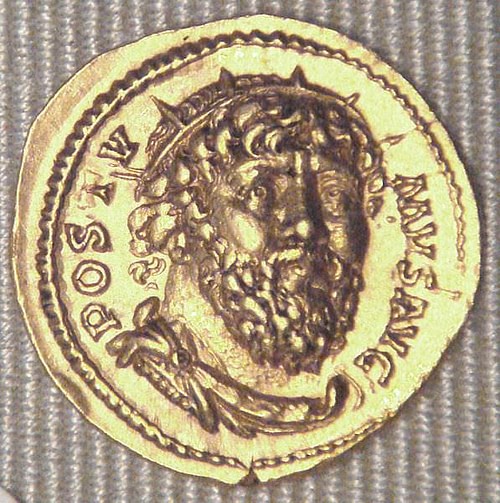
Although Gallienus eventually marched against Postumus, it would prove to be unsuccessful. While the claimant would be opposed by imperial forces and suffer initial defeat, he and Gallienus would never meet in serious battle. The emperor was forced to withdraw, having received a serious wound from an arrow during one of the early sieges. Postumus (260 to 268 CE) would gather his forces and declare himself emperor, claiming the western provinces for himself, being recognized as emperor by Germania, Gaul, Hispania, and eventually Britain. Afterwards, the usurper would establish his capital and residence at Augusta Trevirorum (Trier), complete with a senate and Praetorian Guard. Surprisingly, he made no attempt to march on Rome. Like so many others, in 268 CE he would be murdered by his own men.
Macrianus' Revolt
Meanwhile, the Persians, under Shapur, were causing havoc across the Middle East, retaking Antioch as well as capturing cities throughout Mesopotamia and Cappadocia. Roman commander Fulvius Iunius Macrianus aided by another commander named Ballista defeated Shapur at Corycus on the Cilician coast, forcing him to withdraw his army to the Euphrates. With this success, Macrianus (he believed himself to be too old) declared his sons Macrianus the Younger and Quietus as co-emperors; the pair was recognized in Syria, Egypt, and Asia Minor. Macrianus the Younger and his father advanced northward into the Balkans only to suffer defeat at the hands of the Roman commander Domitianus.
Quietus, who had been left in Syria, would soon suffer the same fate as his father and brother. Septimius Odenathus, the prince of Palmyra and an ally of Gallienus, routed him at Emesa where the townspeople quickly turned on Quietus and put the young would-be emperor to death. Now bearing the titles of Ruler of the Romans and Governor of the East (Dux Orientis), the prince moved against the Persians, and when diplomacy failed, recaptured much of Mesopotamia and Armenia, although he failed to capture the capital Ctesiphon. Unfortunately, in 267 CE Odenathus and his son were murdered in a domestic quarrel. He was succeeded by his wife Zenobia whose forces were defeated by Emperor Aurelian; she was taken to Rome in chains.
Military Reform
For a time, things seemed to be going well for Gallienus. In 268 CE, he named his son Marinianus as his successor, and a decisive victory at Naissus over the Goths and Heruli pushed the Germanic tribes out of the Balkans. Having seen the Persians in battle, Gallienus next believed it was necessary to reorganize the military by not only creating a cavalry corps of armored horsemen but also making the army more mobile and effective. He even banned senators from army commands.
Unfortunately for the emperor, an old ally turned enemy. Aureolus, who had been left in charge of the Roman forces in northern Italy, had turned against Gallienus and joined with Postumus. His men declared him emperor. Instead of moving northward, Gallienus turned towards Italy meeting Aureolus at Mediolanum (Milan). The battle would be short. Gallienus fell victim to conspiracy and assassination; a praetorian prefect, Heraclianus, and the commanders Marcianus and Cecropius. It is also believed that two future emperors were involved, Claudius Gothicus (268 to 270 CE) and Aurelian (270 to 275 CE). While the assassination of Gallienus in 268 CE brought Claudius II to the throne, instability throughout the empire remained.
Legacy
For reasons that remain unclear, history has not been kind to the memory of Gallienus. He was a student of the arts with a love for all things Greek - art, literature, and philosophy, even studying under the Platonic philosopher Plotinus. Like his father, he wanted to bring strength to a suffering empire. His attempt at reform - he repealed many of the anti-Christian edicts enacted by his father - failed to quell the growing uneasiness. Repeated incursions and rebellion from both enemy invaders as well as those who were supposed to be loyal left a shattered empire.



